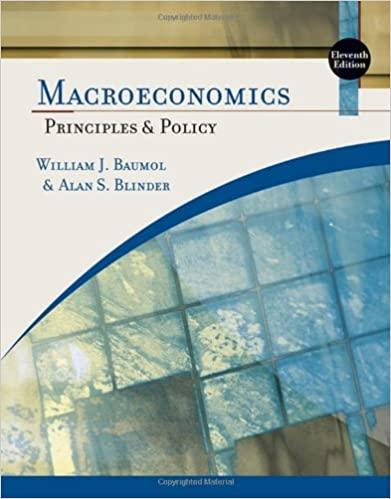Question
In 2019, North Carolina consumed 114,576 thousand barrels of gasoline which is about 4.8 billion gallons.Gasoline demand and supply are both quite inelastic, which means
In 2019, North Carolina consumed 114,576 thousand barrels of gasoline which is about 4.8 billion gallons.Gasoline demand and supply are both quite inelastic, which means that they don't respond much to changes in prices.Short-run demand elasticities have been estimated around -0.2.This means that if the price of gasoline increases by 10%, consumption of gasoline decreases by 2%.Supply elasticities are estimated around 0.1 which means that if the price of gasoline increases by 10%, the supply of gasoline increases by 1%.The supply and demand curves below are roughly consistent with these facts.
Driving your car has many negative externalities, for example:
the negative externality from emissions of carbon dioxide and nitrogen
oxides, the negative externality from increasing traffic congestion, and the
negative externality from causing accidents.Economists have estimated
that these externalities are about $1.60-$2.00 per gallon.
Assume annual demand for gasoline in North Carolina is given by
D(p)= 6 - 0.5p where demand is measured in billions of gallons and p is the
price in $ per gallon.This demand is equivalent to the marginal benefit
curve, MB=12- 2q where marginal benefit is measured in $ per gallon and q is
measured in billions of gallons.Assume annual supply in North Carolina is
given by S(p)=4.2 +0.4p, where supply is also in billions of gallons.This
supply is equivalent to the private marginal cost curve, PMC=2.5q-10.5 where
marginal cost is measured in $ per gallon and q is measured in billions of
gallons.Assume the external cost from the negative externalities is $1.80
per gallon.
This problem analyzes a Pigouvian tax for gasoline consumption
in North Carolina. Be sure to briefly explain any calculations.
1)Market inefficiency
a.Solve for the market equilibrium
gasoline consumption and gasoline price by setting MB=PMC.
i.Hint:I
recommend desmos.com.Don't forget the units!
ii.Calculate
the consumer expenditure on gasoline.(Note that this is also the
producers' revenue.)How much is this expenditure per capita? (There are
10.5 million people in North Carolina.)
b.Solve for the efficient gasoline consumption
by setting MB=SMCwhere social marginal cost is the sum of the private
marginal cost and the external cost: SMC=PMC+XT=2.5q-10.5+1.8.
i.Hint:I
recommend desmos.com.Don't forget the units!
2)Pigouvian tax.The Pigouvian tax
equals the externality cost of $1.80 per gallon.With a Pigouvian tax of
$1.80, the sellers (gas stations or refineries) only receive a portion of the
price you pay at the pump.For example, if the buyer pays p the seller
only receives p-1.8 .Use the following steps to calculate the market
equilibrium with the Pigouvian tax.
a.Graph the demand curve, D(p)= 6 - 0.5p.(Hint:
In desmos.com, enter x=6- 0.5yto get the axes correct.)
b.The seller only receives p-1.8 for every
gallon of gasoline they sell.So supply is now S(p)=4.2+0.4(p-1.8).Graph
the supply curve (Hint: In desmos.com, enterx=4.2+0.4(y-1.8) to get the
axes correct.)
c.Solve for the Pigouvian tax
equilibrium gasoline price and gasoline consumption. Use either desmos.com,
wolframalpha or algebra.
i.Calculate
the total consumer expenditure on gasoline and the total tax revenue.Also
calculate the per capita values.
d.Compare the Pigouvian tax equilibrium
to the market equilibrium in 1.a.
i.Does
the price go up by $1.80?Why or why not?
ii.Explain
what happens to consumer expenditure?(use numbers)
iii.Explain
what happens to producer revenue net of taxes? (use numbers)
e.Compare the Pigouvian tax
equilibrium to the efficient gasoline consumption in 1.b.
f.Calculate the deadweight loss of
the market equilibrium.Provide the value in total and in per capita
terms.
Step by Step Solution
There are 3 Steps involved in it
Step: 1

Get Instant Access to Expert-Tailored Solutions
See step-by-step solutions with expert insights and AI powered tools for academic success
Step: 2

Step: 3

Ace Your Homework with AI
Get the answers you need in no time with our AI-driven, step-by-step assistance
Get Started


